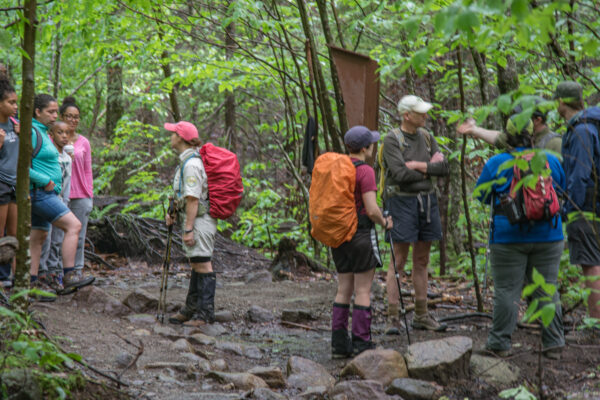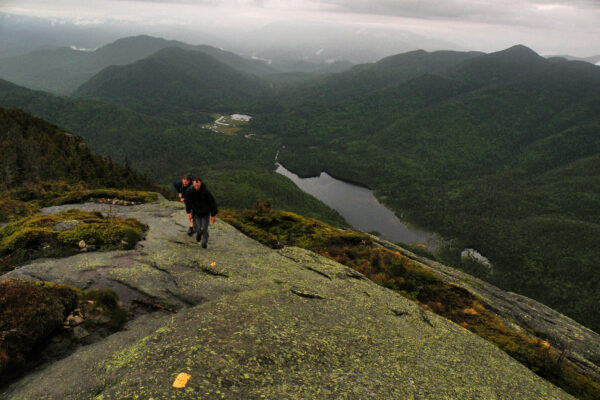The busy season in the Adirondacks is winding down, but with a bang. The Coronavirus pandemic, which depressed visitation for the first part of the summer, has clearly caused a massive spike in recreation. Visitation in many places in the Park is setting records, even with the Canadian border closed. In addition, home and land purchases are skyrocketing.
All this means that the pressure on our natural resources has intensified. But there has been an even bigger impact on our human resources. COVID-19 has increased concerns about public safety at the same time that it has led to a flood of novice hikers. Overworked Forest Rangers and Summit Stewards report an unprecedented number of visitors who are unprepared for the rigors of the Adirondack back country. Meanwhile many facilities and staff, from hiking centers to trail head stewards to shuttles have been less available or not available at all, exacerbating our visitor management challenges. With the overwhelming experience of the last few weeks, concern for the future is high.
All too often the impulse when faced with concerns and fears of the unknown is to take negative measures. Earlier this summer there were protests here where people were actively telling visitors to go home. No parking signs are proliferating and zones are being enforced with tickets and even towing. There is increased talk about developing limited entry systems, such as permit systems.
Adirondack Wilderness Advocates does not criticize measures just because they are negative. In many cases they are undoubtedly necessary for public safety or enforcement of laws. Still, any behavioral psychologist will tell you that it is much more effective to encourage behavior that you want rather than discourage behavior you don’t want. So while we do not necessarily object to negative measures, we’d rather not lead with them. Sometimes we have to, such as closing or restricting facilities that pose a social distance challenge. Sometimes it’s a mixed bag, such as with no parking signs: they have had a positive impact on the residential streets in the hamlet of Keene Valley, while their effectiveness on Route 73 south of Keene Valley is questionable. However, whatever negative steps might be called for, concerns in the absence of concrete knowledge too easily obscure the fact that there is often a better path. Education, information and encouragement are powerful things, and they appeal to people’s better impulses. After all, the great majority of visitors to the High Peaks do not want to give COVID-19 to anyone, nor catch it, nor do they want to damage the Wilderness.
AWA was formed with grass-roots activism. The current protests in America against racial injustice may lead some to interpret activism as negative, but this is simply not the case. It is a fact of history and society that grass-roots activism is fundamentally positive in nature. A grass roots movement cannot be sustained only by oppositional positions; it has to be for something important, for principals and ideals. AWA’s Boreas campaign was not about opposing the State Department of Environmental Conservation, local government or other environmental groups. It was about supporting and promoting Wilderness, remoteness and solitude, about sustaining the beauty of an incomparable wild resource. To that end AWA strove to refrain from politicizing our work, from claiming the sky was falling, from demonizing others or engaging in provocative rhetoric. Since then we have talked a lot as a Board about how we maintain our positive ideals, from forming alliances with local government to working with the State (as on the High Peaks Advisory Group), to declining to engage on private land issues.
In no way does that mean AWA will avoid a tough debate or the need to strongly critique a proposal or action that undermines the Forest Preserve. In fact the opposite is true: to advocate positively for important principles is far stronger than using negativity as a political weapon. The Civil Rights Movement is an object lesson in how true this is. But so is the environmental movement. Aldo Leopold knew it. Bob Marshall knew it. Paul Schaefer knew it. Howard Zahniser knew it. Gaylord Nelson knew it.
AWA is working on proposals to strengthen motorized access policies, identify road and trail changes that increase remoteness and solitude, and facilitate the use of science, data and sound visitor management planning to protect and enhance the Adirondack Forest Preserve as a primarily wild place. As always, we encourage and value your feedback.



